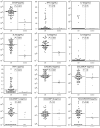Cerebrospinal fluid cytokine levels and cognitive impairment in cerebral malaria
- PMID: 18256412
- PMCID: PMC2254318
Cerebrospinal fluid cytokine levels and cognitive impairment in cerebral malaria
Abstract
Cerebrospinal fluid (CSF) and serum levels of 12 cytokines or chemokines important in central nervous system (CNS) infections were measured in 76 Ugandan children with cerebral malaria (CM) and 8 control children. As compared with control children, children with cerebral malaria had higher cerebrospinal fluid levels of interleukin (IL)-6, CXCL-8/IL-8, granulocyte-colony stimulating factor (G-CSF), tumor necrosis factor-alpha (TNF-alpha), and IL-1 receptor antagonist. There was no correlation between cerebrospinal and serum cytokine levels for any cytokine except G-CSF. Elevated cerebrospinal fluid but not serum TNF-alpha levels on admission were associated with an increased risk of neurologic deficits 3 months later (odds ratio 1.55, 95% CI: 1.10, 2.18, P = 0.01) and correlated negatively with age-adjusted scores for attention (Spearman rho, -0.34, P = 0.04) and working memory (Spearman rho, -0.32, P = 0.06) 6 months later. In children with cerebral malaria, central nervous system TNF-alpha production is associated with subsequent neurologic and cognitive morbidity.
Figures

References
-
- Murphy SC, Breman JG. Gaps in the childhood malaria burden in Africa: cerebral malaria, neurological sequelae, anemia, respiratory distress, hypoglycemia, and complications of pregnancy. Am J Trop Med Hyg. 2001;64:57–67. - PubMed
-
- Hunt NH, Golenser J, Chan-Ling T, Parekh S, Rae C, Potter S, Medana IM, Miu J, Ball HJ. Immunopathogenesis of cerebral malaria. Int J Parasitol. 2006;36:569–582. - PubMed
-
- Schofield L, Ferreira A, Altszuler R, Nussenzweig V, Nussenzweig RS. Interferon-gamma inhibits the intrahepatocytic development of malaria parasites in vitro. J Immunol. 1987;139:2020–2025. - PubMed
Publication types
MeSH terms
Substances
Grants and funding
LinkOut - more resources
Full Text Sources
Other Literature Sources
Medical
Research Materials
